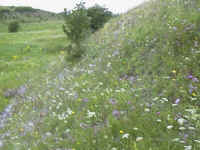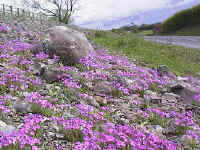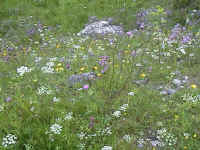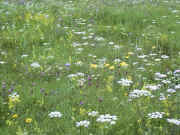|
Native Origin Irish Wildflower Seed Mixtures: Ecotype
Range
Product Code: EC08 - A Bespoke mixture made to site
requirements.
Product Name: Esker Ridge
Burren Type Wild
Flora.
This is a very specific mixture of the most beautiful flora ideally suited to the
Burren Type floras and glacial
Eskers and Esker Ridges that were deposited by glacial rivers across
Ireland, especially in the Midlands. This mixture attracts butterflies.
Ideal for North Clare on Limestone. If you live on a undulating landscape on sandy-stony soil north of
Tullamore, all the way to Lough Rea, East Galway or in West Meath, particularly
north of Athlone, south of Roscommon or south of Mullingar or Northeast
of Kilkenny, then you are probably on an Esker Ridge and have to deal
with a dry, light sandy Esker soil. Occasionally Eskers have wet
spots especially where gravel and sand was removed. Glacial deposits are
even found throughout Ireland in isolated areas, this mixture may also
be suitable. With some maintenance even native Orchids may flourish on
suitable sites.
Species List: Esker Ridge Wild Flora EC08
Birdsfoot Trefoil
Black Meddick
Bladder Campion
Burdock
Burnet Saxifrage*
Centaury*
Corn Marigold
Corn Pansy
Corn Poppy
Corncockle
Cornflower
Cowslip
Eyebright
Field Poppy (long headed)*
Field Scabious
Greater Knapweed*
Broadleaf Plantain,
Kidney Vetch
Lady's Bedstraw
Lesser Knapweed
Marjoram
Scentless Mayweed
Mullein
Ox-eye Daisy
Red Bartsia*
Red Clover
Ribwort Plantain
Rough Hawksbit
Selfheal
Shepherds Purse
Smooth Hawksbit
St Johnswort
Weld -Yellow weed
Wild Carrot
White Campion
Wood Avens
Yarrow
Yellow Agrimony
Yellow Rattle*
White Stonecrop
Nottingham Catchfly*
Fairy Foxglove
Primrose
Quaking Grass
Salad Burnet
Biting Stonecrop
Fairy Flax*
Lesser/Yellow Clover 'shamrock'

*Denotes
a species that is either of diminished national geno-type or specific to
only a few sites, or who's habitat is increasingly threatened, or the
species is uncommon, rare, becoming rare, is endangered, reintroduced or
saved from extinction.
In all cases, your purchase contributes to DBN's work of creating crops
of Conservation Grade - Native Origin Wildflora. You help us to inform
and pay land-owners to manage native species and to assist DBN in
handing on our heritage for another generation.
By growing (some will be difficult) these and all other species, you
directly help to conserve national and global Biodiversity and protect
wildlife. You should also consider yourself another Irish wildflower
grower.

Product
Warning: While
this Ecotype mixture contains the seed of edible and herbal species, DBN
recommend that this mixture is not for human or animal consumption as it
contains species such as Corncockle which is toxic if
ingested. Wild Parsnip can irritate the skin.
Seed
Mixture Specifications:
Total number of seeds per gram: 2810
Native Irish Origin, Wildflower Seed Mixture. EC08
Suitable for soil type: Sand,
Light Soil and Quarries
Moisture Level: Very Dry, Dry, Normal, Occasionally Moist, but not Flooded Wet
pH range: Best between 6.5 >7.9
Aspect: Sunny, occasional shade and not deeply shaded.
Morphology:
Life Cycle: Annual / Biennial /
Perennial.
Height Range: <30cm to >100cm
Flowering Period: March to September, but may falter in
very dry summers, however species will recover.
Fertility Range: Will
grow slowly in very poor soil, if very
infertile apply fertiliser (see below).
Wintergreen: No, if required sow with grasses
The main species which should dominate and persist in this
mixture if the ground is kept free of rough grass : Birdsfoot
Trefoil, Black Meddick, Bladder Campion, Burnet Saxifrage, Cowslip,
Field Scabious, Broadleaf Plantain,, Kidney Vetch, Lady's Bedstraw, Lesser Knapweed,
Marjoram, Ox-eye Daisy, Red Clover,
Ribwort Plantain, Rough Hawksbit, Selfheal, St Johnswort, White Campion,
Wood Avens, Yarrow, Yellow Agrimony, Salad Burnet.
Annual
Species: Centaury, Yellow Rattle, Eyebright, Red Bartsia, Yellow Rattle, Corn Chamomile, Corn Marigold, Corn Poppy, Field Poppy (long headed),
Corncockle, Cornflower, Scentless Mayweed, Shepherds Purse, Nipple Wort
Biennial Species: Burdock,
Mullein, Wild Carrot, Wild Parsnip, Weld -Yellow weed,
Rare, unusual, and feature species: Fairy Foxglove,
Fairy Flax, Lesser/Yellow Clover 'shamrock', Primrose, Quaking Grass, Smooth Hawksbit,
Biting Stonecrop, Greater
Knapweed, White Stonecrop, Nottingham Catchfly.
Species which will grow if the conditions are ideal: All, this mixture suits mainly limy dry
sandy well drained soils. In some cases moisture will be tolerated and
individual species may thrive such as Rattle and Trefoil.
Species which will be affected by management: Red
Bartsia and Yellow Rattle, if left uncut will not persist.
Bluebell will need shade from shrub or overhanging trees. White Campion
will establish if there is erosion or a sunny open dry
microclimate.
Additional species which could be added to this mixture as individual species of seeds or plants:
Blackstonia. Occasional woodland of Ash and Hazel under
planted with Bluebell. Stand alone thorn bushes and Scots
Pine would all
help improve this ecosystem.
Design
Notes:
EC08 is one of my favourite seed mixtures, it flowers over a long time,
is very colourful rich in th Scabious Family and attracts
butterflies. Grasses should be carefully chosen and if at all possible,
source them locally, by getting spoil from quarries and spreading it
before sowing EC08.

Sowing Specification:
As Normal, roll or rake into surface to
keep out of reach from birds. Sow this mixture in Autumn
and early Spring so the seed can germinate before the soil dries out.
Soil Preparation:
To establish, especially since it will be sown on low nutrient
soils, fertiliser or weed free organic matter may be required to aid
germination.
Optimum Sowing Time: Late spring, early
autumn, when the soil is damp.
Sowing Conditions:
Normal. protect from rabbit as germination emerges in 6th to 10 week
after sowing
Sowing Method: By hand is recommended, if
using seed spreaders be careful to insure the small varieties of seed do
not drop to the bottom of the seed spreader and get sown all in the one
place. Can be Hydrasown.

Fertiliser: Yes, on pure Esker soils to
aid establishment, once established no fertiliser will be required., Powdered or liquid seaweed will aid germination.
Seed Sowing Rates:
1.5 grams per metre.
Normal
sowing rate 'without added grass seed':1.5 grams per metre.
High sowing rate 'without added grass seed': Add 3 grams per metre.
Grass
seed or nurse crop requirement:
Nurse
Crop: No nurse crop is required.
Grass Seed Requirement: Locally sourced
grasses from the eskers or Common Bent, Meadow Grass, Meadow Foxtail,
Fescues, Sweet Vernal Grass and Oat Grass.
Sow with or without grasses: Either
Sowing rate with grasses: 2 to 4 grams per metre.
50% Flora / 50% grass seed, or up to 80% grass at 6 to 7 grams per metre
where erosion may occur.
If
sown without grasses: This mixture will not require a nurse crop.
Seed Specification:
In normal conditions (mainly in early Autumn and Spring) this mix should germinate 6
to 10 weeks
after sowing, from then on provided the sward is kept open and a 'Thatch' is not allowed develop, species will continue to germinate and emerge, through
to the third year.
Up to 60% of all seed should germinate in the first year.
Up to 50% of all species should germinate in 12 months.
Up to 90% of all species
should have flowered by the fourth year after sowing.
Performance:
Attracts many butterfly species.
If
this mixture is sow with annuals, or contains annuals, they will flower profusely
in the first year, provided they are sown before June. They require one
cut when finished flowering. In the second year the biennials will also
be very colourful. Cut once in late August.
In the third year this meadow mixture will seem
to have less flora than the first and second year. Why?
The perennial species are still young, many will only have
germinated in the second season, so flowers will be sparse. However,
there should be identifiable foliage and some flowers. If not contact
us.
In the second and third the native grasses in your soil will have grown
and will be emerging so strongly that the meadow will require two cuts,
one in Spring and the Second in July or August, the meadow can again be
cut in September if the grasses are still growing strong.
When
should this meadow be established and require one cut.
In the fourth year the perennials in the mixture should be flowering on
many stems and starting to clump and spread, again if the grass is still
vigorous cut in spring and in August of the fourth year. However if the
perennials are growing strong there will be no need to cut until July,
August or September depending on the fertility and wetness of the soil
and the species which have grown.
A
wildflower meadow should last many years, provided the species
established, weeds were controlled and the meadow was cut and the cut
material removed and occasional 'Gaps' are created. If not contact DBN.
Persistence if unmanaged: High, the dryness
of the soil should control vigorous growth, watch out for shrub and tree
species in no cut situations.
Tolerance of Cutting: High
General Cutting Time: Mid to end of Summer. Cutting may be hazardous on steep slopes.
Specific Cutting Time: Wait 3 weeks until after the last flush
of flowers fade away, after seeds set.
Management: Control grasses and weeds until
well established.
Most
species in this mixture are 'Browse' resistant. Encourage
rabbit once flora is established.
A
General Description of this product and the 'Ecotype' Range:
Ecotype seed mixtures are
designed to imitate natural ecologies found in specific situations. EC08
is intended as an exact copy of an Irish Esker, many of the species were
sourced by DBN from Esker Ridges since the 1980's and reproduced in our
nurseries.
This range of seed mixture is ideal for those concerned with encouraging wildlife and local biodiversity as
the plants will attract species suited to the ecology.
If this mixtures is suitable for your situation, it offers good value, contains some of the most exacting and unusual species and if
given time, develop into a diverse flora that will persist if properly maintained.
|
|



